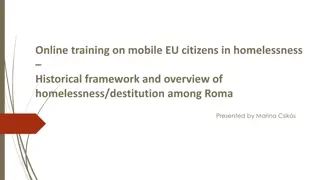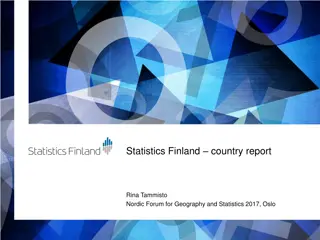The Roma Community in Finland: History, Culture, and Challenges
The Roma community in Finland, one of the national minorities, has a rich history dating back to the 1500s. Their culture emphasizes cleanliness, good manners, and respect for the elderly. Despite efforts to preserve their language and culture, discrimination and societal challenges persist, impacting their education and employment opportunities. The Roma National Day on 8th April celebrates their heritage. Learn more about the Roma in Finland's journey towards cultural preservation and societal integration.
Download Presentation

Please find below an Image/Link to download the presentation.
The content on the website is provided AS IS for your information and personal use only. It may not be sold, licensed, or shared on other websites without obtaining consent from the author. Download presentation by click this link. If you encounter any issues during the download, it is possible that the publisher has removed the file from their server.
E N D
Presentation Transcript
Finnish Roma The Roma are one of the national minorities in Finland. More than 10,000 Roma live in Finland. The Roma culture emphasises cleanliness, good manners and respect for old people, which is visible in their dress codes, among other things. The Constitution of Finland guarantees the right to foster their language and culture to the Roma. Source: Wikimedia Commons (PD) The Roma National Day is celebrated on 8 April. 2022 2 11 November Finnish National Agency for Education
The mother tongue of the majority of the Roma in Finland is Finnish. The number of people who speak the original Romani language has declined and most of them are elderly. The Romani language Efforts have been made to improve the position of the language for example by providing instruction in the Romani language in comprehensive schools. Today, it is possible to complete a test in the Romani language as part of the matriculation examination and it can be studied as a minor subject at the University of Helsinki. Finnish National Agency for Education 3 11 November 2022
History of the Roma It is believed that the Roma originate from India, from where they began to wander towards Europe in the Middle Ages. The first Roma arrived in Finland in the 1500s. For centuries, the Roma had a wandering lifestyle working, for example, as craftsmen and traders. After the mid-1900s, the majority of the Roma in Finland have settled to live in towns and cities. However, the Roma culture has maintained its original characteristics. Source: Museum of Central Finland (Finna.fi) (CC-BY ND 4.0) 4 11 November 2022 Finnish National Agency for Education
The authorities and the Church discriminated against the Roma for centuries. 5 11 November 2022 Finnish National Agency for Education In the 1600s and 1700s, efforts were made to expel the Roma from Finland and church ceremonies were prohibited from them. Discrimina tion of the Roma From the 1880s, efforts were made to integrate them into the majority population. In the past few decades, the government has begun to take a more favourable attitude to the Roma culture. However, discrimination and prejudices against the Roma are still common. For example, the police and security guards have performed ethnic profiling of the Roma.
6 Discrimination and the disappearance of the traditional livelihoods have weakened the societal status of the Roma. The level of education and the employment rate of the Roma are lower than in the population on average. Societal status of the Roma For example, it is difficult for persons with a Roma background to find a place to live and a job. Many Roma find that the surrounding society does not understand or value their culture. 11 November Finnish National Agency for Education 2022























